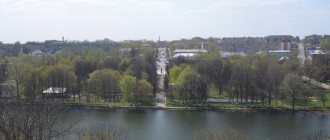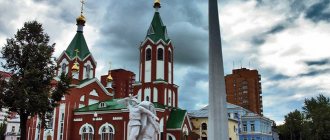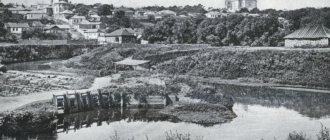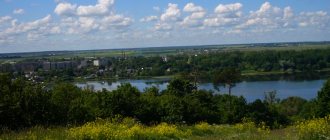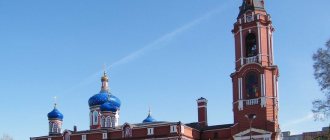The city of Danilov - attractions
The city of Danilov at the present time. This is a small town in the Yaroslavl region on the banks of the Pelenga River. Its population is only 14.5 thousand people. In the east, the Danilovsky district borders the Kostroma region.
The city is a major railway junction. There are 15 railway tracks and a junction station of different types of current - alternating and direct.
View hotels in Danilov on Booking.com =>>
Kazan Cathedral
The most significant architectural monument of Danilov. Located on the outskirts of the city. This cathedral is all that remains of the ensemble of the Kazan Convent. Founded at the end of the 19th century, the monastery constantly experienced financial difficulties. Even the construction of the main cathedral stopped for many years.
The beautiful red brick cathedral was illuminated under Soviet rule - in 1918. Now the cathedral is gradually being restored, protected by the monastic community recreated here. The temple is worth a visit to admire the architecture, unusual for the Yaroslavl land.
Details
Historical reference
The history of Danilov began in the mid-15th century. The village of Danilovskoye is mentioned in the charter of Grand Duke Vasily 2 dated 1457. According to this charter, all the Danilevo environs belonged to Jonah of Moscow, Metropolitan of All Rus'. In 1592, Danilovskaya Sloboda was already mentioned. In 1607, to fight the Poles, a militia was organized in Danilov under the command of the boyar Fyodor Sheremetev. The Poles were completely defeated in a fierce battle. The place where the battle took place is located across the Pelenga River and is now called “Povalishka”, in honor of that battle. At this place there is a worship cross and a memorial stone. In 1608, the Poles again attacked Danilov and managed to capture it in battle. The city was burned, many local residents died.
At the end of the 18th century, Danilovskaya was considered a large settlement. In the village there was a stud farm that supplied horses for the troops of Peter 1. In 1713, a stone church was built in the village - the Smolensk Cathedral. The settlement of Danilovskoye was considered a palace village. Alas, the cathedral was destroyed in 1940.
In 1777, Danilovskaya Sloboda received the status of a district town of Danilov. In 1778, the city's coat of arms was approved. A significant event in the life of the city occurred in 1870. The implementation of the project for the construction of the Yaroslavl-Vologda narrow-gauge railway and the construction of a small railway station began. Passenger train service began in 1872. Later this railway developed into a broad-gauge one.
The city gradually grew. At the end of the 19th century there were 9 factories in the city.
In 1895, a terrible fire happened in Danilov, and the city almost completely burned down. In 1918, another railway line was built. In 1935, a new railway station was built in the city, and in 1941, a woodworking machine factory was built. At that time it was the only one in the country, and its products were also exported. In 2009, the plant was declared bankrupt. As we can see from the history of the city, its best times are in the past.
View hotels in Danilov on Booking.com =>>
Danilovsky Prison Castle
Located in the center of the city. The building was built in the 19th century. Since it was constantly used and repaired until the 2000s, it was well preserved. Thanks to local historians, the prison castle is actively included in the tourist life of Danilov. Although there are no funds for its full restoration.
A visiting tourist without prior arrangement will be able to view the castle only from the outside. By calling the staff of the local history museum, you can count on a sightseeing tour of some of the premises. The guide will tell you that Alexander Solzhenitsyn was kept in the castle for some time and that in the entire history of the prison, only one prisoner escaped from it. The value of the object lies in the fact that throughout Russia there are at most two or three more such prison castles left.
Location: Yaroslavskaya street - 6.
Danilov
Danilov is a city in the Yaroslavl region. Population - 14,522 people. (2020). Located in the Pelengi River, in close proximity to its source. It is located 351 kilometers northeast of Moscow.
Story
The village of Danilovskoye was first mentioned in documents from the mid-15th century. Thus, from the charter of Grand Duke Vasily II dated March 20, 1457, it follows that the village of Danilovskoye with the surrounding wastelands (arable lands) belonged to the Metropolitan of All Rus' Jonah of Moscow.
Soon, already under the reign of Ivan III, the village changed its owner. As a result of the exchange, it passes to the Moscow governor Ivan Dmitrievich Runo. In 1592 it was mentioned as Danilovskaya Sloboda in the manuscript “The Book of the Rosiski Saints.”
Increasingly, the name of Danilov as the Danilovsky village or Danilovskaya Sloboda begins to be mentioned in documents from the first half of the 17th century, during the Time of Troubles. In 1607, one of the Polish detachments under the leadership of the Lithuanian nobleman Alexander Lisovsky approached the Danilovskaya Sloboda, began to rob the population, burn houses and buildings in nearby villages, and kill residents. Then the Danilovites organized a militia under the leadership of the boyar Fyodor Sheremetev.
A bloody battle took place in which the Poles were defeated. The battle took place across the Pelenda River, to the right of the road leading to Romanov. Since that time this place has been called Povalishka. In 2009, a worship cross and a memorial stone were installed near the battle site.
At the beginning of December 1608, a detachment of Vologda residents led by Larion Monastyrev, heading towards the “thieves” to Yaroslavl, occupied the Danilovskoye village. The squads set up a fort in it and fortified themselves. Danilovites took an active part in the creation of the fortification. However, this people's militia was poorly organized and could not withstand superior forces. In the same year, the fort was surrounded by Polish troops and, after a short battle, was taken, and the village of Danilovskoye and its surroundings were burned out and devastated. The Nikon Chronicle says that the invaders “killed many honest people.” Many village residents were exterminated. The place where the battle took place and the fort was located has survived to this day - Zemlyanoy Val Street.
New time
At the end of the 17th century, the Danilovskoye village became a large settlement with markets and prisons.
Under Peter I, there was a stud farm in the settlement that supplied horses for the army. In 1713, the stone Smolensk Cathedral was built to replace the old wooden church (dismantled in the 1940s). The settlement was considered the palace village of Danilov, and the palace Danilovskaya volost was included in the Lyubimsky district of the Kostroma province.
In 1777, with the establishment of the Yaroslavl governorship and province, Danilovskaya Sloboda was transformed into the district town of Danilov (officially - August 3, 1777). The opening of the city and public places took place on December 30, 1777. The city was (and is) located on a large road leading from Moscow and Yaroslavl to Vologda and Arkhangelsk, and there was a weekly market there. The population numbered 1,290 people, mostly engaged in trade and craft. There were 278 houses, including four stone ones. In the settlement there were several handicraft workshops, a copper samovar factory with 35 employees, two wax factories, three candle factories, and three dye factories. There were two parish schools, which annually graduated 35-40 people, three churches, two of which were wooden.
In 1787, there were already 357 residential buildings, 115 shops, 8 forges in Danilov, and the number of enterprises increased. The city at that time had a diameter of 1 km.
The importance of the city as a stop on the way from Moscow to Arkhangelsk grew. Residents were engaged in latrine farming, arable farming and gardening. The city was famous for the sale of canvas, which was bought up from the surrounding population on market days and sent to St. Petersburg and Moscow. Horses, cattle, and manufactured goods were sold at the fair. In 1864, two parochial schools were opened: one for boys (about 30 students) and one for girls (less than 20 places). In the middle of the 19th century, there were 9 factories in the city: 2 samovar and candle factories, a brick factory, a leather factory, a molasses factory, a brewery factory and a gingerbread factory. All together they produced products worth up to 250 thousand rubles. in year. Local copper factories produced samovars, coffee pots, teapots and other copper utensils that were sent to the capitals. Molasses was sold at the Nizhny Novgorod and Rostov fairs.
In 1870, a project was approved for the construction of the Yaroslavl-Vologda narrow-gauge railway (later rebuilt into a broad-gauge railway), which, at the request of townspeople and local authorities, was built near the city itself on land unsuitable for cultivation called “Goat Swamp”. On January 29, 1870, construction began on the station building: a wooden one with a small waiting room and kerosene lighting. In January 1872, passenger traffic opened from Danilov to Yaroslavl, and in June - from Danilov to Vologda. More than 300 people passed along the road every day. The passenger train from Danilov to the Yaroslavl station Uroch took about 4 hours.
In 1873, there were 14 taverns and 36 taverns in the city. There were 20 kerosene lanterns and 2 stone-paved streets. A large stone building for shops was built on the market square. The alleys around Preobrazhensky Pond, which has now been destroyed, and the station, especially when trains arrived, served as a place for townspeople to walk. In 1892, 3,616 people lived in Danilov; There were 12 of all industrial enterprises, including small ones. In 1895, the city was almost completely destroyed by fire. In 1910, the city had 1 hospital with 30 beds, 2 pharmacies, 2 doctors, 3 paramedics, 4 craft institutions, 6 lower educational institutions with 464 students. There were no theaters, libraries, or secondary educational institutions. In 1917, the city had 13 streets and less than 5 thousand inhabitants. In 1918, the Danilov-Bui section of the railway came into operation.
Modern times
In 1930, a new railway station was built in the constructivist style. In 1941, the Danilovsky woodworking machinery plant was built - at that time the only one in the country that also worked for export.
Attractions
Among the main architectural attractions of the city: the Kazan Monastery on Gorushka (1918), the house of the merchant Vorokhobin (late 19th century), the fire station complex (1864-1872), the building of the city school (mid-19th century), the house of the merchant Kruglikova (late 19th century), police department building (late 19th century), Yagodina rooms building (late 19th century), Yagodina hotel building (late 19th century).
The place of memory for Danilovites is the Alley of Heroes of the Soviet Union, fellow Danilovites, where in the very center stands the figure of a Russian soldier, at the foot of which the Eternal Flame is lit. In the center of the city there is a monument to the fallen fighters for the establishment of Soviet power in the city.
Interesting Facts
- In the city of Danilov, on February 28, 1920, actor Alexey Smirnov was born into the family of Makar Stepanovich and Anna Ivanovna Smirnov.
- The mother and father of the famous actress Tatyana Vasilievna Doronina were born in Danilov. During the Great Patriotic War, as a child, she was taken from Leningrad to Danilov. Today, many relatives of the actress live in the city. And she herself considers the Danilovites her fellow countrymen.
- In the novel by Soviet writer Vladimir Orlov “Violist Danilov” (1980), the main character (a demon on his father’s side) receives his surname from his place of birth in the city of Danilov, Yaroslavl region.
- In 1977, Hero of the Soviet Union Alexander Dmitrievich Shcheblakov was awarded the title of Honorary Citizen of the city of Danilov.
- In the city of Danilov (formerly Dvortsovoye village of Danilovsky, Kostroma district), the Russian ore explorer (geologist) Kapustin Grigory Grigorievich was born in 1680, whose name is associated with the beginning of coal mining and intensive industrial development of Donbass.
House of Culture
Today, perhaps, only a specialist or a very experienced lover of antiquities will be able to recognize the former temple in the house of culture of the city of Danilov. There are no domes or under-dome drums; the temple space is divided into floors.
The Resurrection Cathedral, like many churches in our country, was greatly rebuilt, but at least this saved the building from complete destruction. It is known that in 1918 Patriarch Tikhon visited it and held a service. A memorial plaque on the facade of the building tells about this.
Location: Cathedral Square - 7.
Historical and Local Lore Museum named after P.K. Sharapov
For a small town, Danilov has a surprising number of museums—as of recently, as many as three. The local history museum is the oldest, dating back to 1967. The exhibition is very rich and built according to all the canons of museum work. The visitor will learn about the nature of the region, get acquainted with the main milestones in the history of Danilov, learn about the most significant events and distinguished citizens. Much attention is paid to the heroic past and various types of crafts that existed and exist on Danilovsky land. There is a wonderful park next to the museum.
Location: Cathedral Square - 5.
Links[edit]
Notes[edit]
- ^ abcdefg Law No. 12-z
- ^ a b Federal State Statistics Service (2011). “All-Russian Population Census 2010. Volume 1" [All-Russian Population Census 2010, vol. 1]. All-Russian Population Census 2010 [All-Russian Population Census 2010]
. Federal State Statistics Service. - "26. The size of the permanent population of the Russian Federation by municipalities as of January 1, 2021". Federal State Statistics Service. Retrieved January 23, 2021.
- ^ abcd Law No. 65-z
- Federal State Statistics Service. Federal Agency for Technological Regulation and Metrology. No. OK 033-2013 January 1, 2014 “All-Russian classifier of municipal territories. Code 78 615.” (Federal State Statistics Service. Federal Agency for Technological Regulation and Metrology. No. OK 033-2013 January 1, 2014. Russian classification of municipal territories. Code 78 615.
). - "On the Calculation of Time". Official Internet portal of legal information
. June 3, 2011. Retrieved January 19, 2021. - Post office. Information and computing center of OASU RPO. ( Post office
).
Search for postal service objects ( postal Search for objects
) (in Russian) - ↑
Federal State Statistics Service of Russia (May 21, 2004).
“The population of Russia, the constituent entities of the Russian Federation as part of federal districts, urban settlements, settlements, settlements is 3 thousand or more people” [Population of Russia, its federal districts, federal districts, districts Urban settlements, rural settlements - administrative centers and rural settlements with a population of over 3,000] (XLS). All-Russian Population Census 2002
. - “All-Union Population Census of 1989. The current population of union and autonomous republics, autonomous regions and districts, territories, negative phenomena, urban settlements and rural district centers” [All-Union Population Census of 1989: current population of union and autonomous republics, Autonomous regions and districts , territories, regions, districts, towns and villages performing the functions of district administrative centers. All-Union Population Census of 1989 [All-Union Population Census of 1989]
.
Institute of Demography of the National Research University: Higher School of Economics [Institute of Demography of the National Research University: Higher School of Economics]. 1989 - via Demoscope Weekly
.
Railway Junction Museum
In fact, this is a branch of the local history museum, but it has its own building and a unique collection, formed independently of the collection of the main museum. It began as a corporate museum; several years ago the collection was transferred to the local history museum. Which made the museum more accessible.
Visitors are presented with interesting exhibits from the history of the Danilov railway junction starting from the 19th century. The highlight of the museum is an old steam locomotive.
Location: Vyatskaya street - 4.
Danilovskaya Art Gallery
The gallery was founded in 1997. The collection is based on works by local artists and photographers. Not only artists from the cities of the Yaroslavl region, but also from all over the country consider it an honor to exhibit in this gallery. Visitors are constantly offered new exhibitions, excursions and master classes are held in various areas of artistic creativity. The gallery hosts a permanent exhibition and sale.
Location: Volodarsky street - 45.
Coat of arms and flag
Coat of arms of Danilov 1778.
The city's coat of arms was approved, according to some sources, on June 20, and according to others, on August 31, 1778. It is a shield divided in half; one half of it is silver, and the other is checkerboard. A bear with an ax on his shoulder emerges from the chessboard into the silver one - belonging to the Yaroslavl governorship. According to the version of the Hermitage restoration artist P. F. Kalikin, the chess field appeared on the city’s coat of arms in memory of the gift of the townspeople to Peter I - silver chess. According to a historical parable, Peter I once examined Danilov, he did not like many things and he became furious. But Danilov’s people found out about his passion for the game of chess and brought him a chess set with silver pieces, which the tsar liked and was allegedly later exhibited in the Hermitage. The green color represents the rich pasture meadows near the city.
In 1999-2009, the old coat of arms of the city was the coat of arms of the Danilovsky district. Based on this coat of arms, the modern coat of arms and flag of the city were created, in which the image of a bear was changed (approved on May 24, 2007). The coat of arms is decorated with a silver tower crown (the city crown of the district city).
Shopping arcades
Every Russian city had shopping arcades. Danilov was no exception. In the 70s of the 19th century, the Danilovites managed to replace the old wooden shopping arcades with stone ones. They still exist in the city and are in good condition.
The local population does not have any special reverence for the monument and uses the rows for their intended purpose. There are many shops located here, which means a tourist can not only purchase local and imported goods for himself, but also freely explore the simple interiors of the Trading Rows.
General information about Danilov
The city's economy is based mainly on enterprises related to the railway, forestry and food industries. The forest is one of the main assets of the Danilovsky district - it occupies more than 51% of its territory.
The city's educational institutions include three secondary schools and the Danilovsky Polytechnic College.
During the Great Patriotic War, the city of Danilov was not damaged, so there are many wooden buildings from the century before and last. Among them there are interesting architectural and historical monuments.
St. Nicholas Church
A very interesting temple, located a stone's throw from the Trading Rows. Built in 1910, it is an excellent example of the pseudo-Russian style widespread at that time. The temple resembles more of a fairy-tale tower. It is known that a church existed on this site until the 20th century. The temple is now operational and is being gradually restored.
Location: Karl Marx street - 19a.
Northern summer resident - News, Catalog, Consultations
The early period of Danilov's history is associated with the Finno-Ugric tribe Merya. In the 5th-10th centuries, the lands on which the city of Danilov is located belonged to this tribe. The name of the river on which the city stands - Pelenda, which translated from the Meryan language means “tasty water”, still reminds us of the most ancient people who inhabited these regions. The modern coat of arms of Danilov is based on the historical coat of arms of the city of Danilov, approved in 1778, and is a shield divided diagonally in half, from bottom to top, from left to right, the upper part of the coat of arms is a silver field, the lower part is a chess field with alternating green and white cells . A bear emerges from the chessboard into the silver one, holding in its left paw a golden ax with the same handle.
Tradition says that in this place there was a settlement of the Merya tribe and it was called Pelendovo. Later the Slavs came to these places. There is information that the village of Danilovskoye appeared here in the 13th century. Tradition attributes the founding of the village to the first Moscow prince, the youngest son of Alexander Nevsky, Daniil.
Prince Daniel, after the death of his father, traveled around the northern lands. He liked this place, and he ordered to build princely chambers on the right bank of the Pelenda, and stables on the left. Then other buildings appeared - a church, barns, houses. This settlement received the name of Prince Daniil, the founder of the dynasty of Moscow princes. This is how the village of the palace department of Danilovskoye appeared. This is how Danilov’s story began.
Lovers of antiquity of the 19th century in the city of Danilov believed in this legend and were even ready to indicate the exact place where certain buildings of Danilo were located. In fact, the founding of Danilov by the father of Ivan Kalita has not yet been confirmed by reliable historical sources. The first documentary evidence of the existence of Danilov dates back to 1592, when the Danilovskaya Sloboda was mentioned in the manuscript “The Book of Saints of Russia.” This is the first reliable fact in the history of Danilov.
The village of Danilovskoye gained fame in connection with the events of the Time of Troubles. In 1607, local residents defeated here the detachment of Fyodor Pleshcheev, a supporter of False Dmitry II.
But the following year Danilovskoye was captured and burned by interventionists.
After the founding of Arkhangelsk, an important seaport through which trade between the Russian state and Western Europe was carried out, Danilovskoye found itself on the trade route from Moscow to Arkhangelsk. Huge masses of goods were transported past the village in both directions. This was a stopping place; there was a brisk trade in food supplies and products of local artisans. In sources of the 17th-18th centuries, Danilovskoye is repeatedly mentioned as a populous palace village.
In the description of the Dutch ambassador Kunraad Fan-Klenk, who was traveling to Moscow, we read: “On January 1, 1676, the embassy passed through a beautiful village - Danilovskaya Sloboda, similar in size and beauty to a city with markets and prisons.”
The Dutch artist Cornelius Bruni, who traveled from Arkhangelsk to Moscow in January 1702, describes Danilovskaya Sloboda as a beautiful and large place where trade is carried out and there is a large stud farm owned by the Tsar, which has more than two thousand horses.
This stud farm supplied horses to the army under Peter I. In 1713, on the site of a wooden church, the stone Smolensk Cathedral was built (dismantled in the 1940s).
The next stage in the history of Danilov is associated with the formation of the Yaroslavl governorship in 1777. Alexey Petrovich Melgunov became the first governor. He described the natural conditions of the Yaroslavl region, and also prepared lists of cities and county maps. Alexey Petrovich envisioned the division of the Yaroslavl governorship into 12 districts. The village of Danilovskoye became the center of the newly formed Danilovsky district, and it was transformed into the city of Danilov.
Danilov received official status as a district town on August 3, 1777.
“Public places” were opened here, where officials sat who were in charge of various aspects of the life of the city and the Danilovsky district formed under it. This happened on December 30, 1777, and in 1778 the coat of arms of the city of Danilov was approved - “a shield cut in half at random, one half of it is silver, and the other is chessboard; from this latter to the first, a bear coming out with an ax proves that the city belongs to the Yaroslavl governorship.”
What was the young town of Danilov like then? There is a “Topographic Description of the Yaroslavl Province”, completed in the 90s of the 18th century, from which we learn that in the newly formed city there are no monasteries and city fortifications, there are three churches. There are government buildings: a police and a prison in one building, two salt stores; the house where the zemstvo court and the district treasury are located; the houses where the managers of the palace parish lived were all wooden. There is also a brick and mortar wine shop outside town. There are five drinking houses in Danilov, three public city houses, in the first there is a city magistrate, with accessories, in the second there is a district court, and in the third there is a mayor. The cash treasury is kept in a separate tent near the cathedral bell tower. There are 82 wooden shops; There are 257 wooden houses, 3 two-story stone houses, and 1 one-story house. All residents in the city are 1291 people.
Having become a county town, Danilov received a regular development plan. It was adopted in 1780 and amended in 1834. This plan is simple and rational. Its basis is streets intersecting at right angles, running from north to south and from west to east. Within this structure, two centers were identified: religious (Cathedral Square) and administrative and commercial (Torgovaya Square).
In the city of Danilov there was a weekly market. Danilov merchants and townspeople traded in linen, bread, meat, cow butter, and sheepskins. The city had its own small industrial enterprises: a tannery that produced fine yuft, two dyeing factories that dyed homespun fabric, and five lard-making and candle factories. Outside the city there was a state-owned water mill. In addition, there were three windmills.
The materials needed for factories: canvas, leather, wax, lard were bought at city and rural fairs. Danilovskaya yuft, canvas, bread and candles found good sales in St. Petersburg, Moscow and nearby cities, almost all of the dye was sold in Danilov, and tallow candles went to Kostroma and Lyubim. A significant part of the people were engaged in gardening. Many men were away.
In the 19th century there was some growth in the commercial and industrial importance of the city. So, in 1863, there were already 465 houses in Danilov, including 28 stone ones. The number of residents increased to 3,207 people. The city had two linen factories, two tanneries, two tallow factories and one copper factory, which employed 35 workers. The plant produced samovars, coffee pots, teapots and other copper utensils. Danilov samovars were in great demand on the market. Samples of them can be seen in the folk museum.
There were two parochial schools: one for boys (about 30 students) and one for girls (less than 20 students). A public bank was opened with a capital of 15,000 rubles, and a stone hospital building was built with funds from the zemstvo.
In January 1872, passenger traffic was opened on a narrow railway from Danilov to Yaroslavl, and in June - from Danilov to Vologda. More than 300 people passed along the road every day. In the 70s of the 19th century, a fire yard with a wooden watchtower and stone premises for firefighters and convoys, stone shopping arcades, and a wooden railway station building were built in the city.
At this time, the city had 14 taverns and 36 taverns, and at the same time there is information about only two elementary parish schools, from which 29 boys and 6 girls were graduated. The city had only 2 paved streets and was illuminated by 20 kerosene lanterns.
In 1895, a tragic event occurred in the history of Danilov - there was a big fire, the city almost completely burned out, so the Danilovites had to essentially rebuild their city from the ruins.
Judging by the information that has reached us, Danilov was rebuilt very quickly. According to data for 1906-1911, in Danilov there were 655 one- and two-story houses, mostly wooden, in which 4,770 people lived. It was lit by 105 kerosene lanterns. In 1912, a power plant was launched and electric lighting appeared on the streets. In Danilov at that time there was a hospital, two pharmacies, a bathhouse, two almshouses, and an orphanage. There was also a public library, a teahouse with a reading room, and a club serving the merchants and city nobility. In 1915, a small private cinema was opened in the city. In 1913, a second track was laid on the railway from Yaroslavl to Danilov, and the narrow gauge was replaced by a wide one.
Prosperous and strong, merchant and craft city of Danilov. This is how he was before the revolution.
New changes in the history of Danilov occurred after the revolution of 1917. In February 1918, Soviet power was established in all volosts of the Danilovsky district, although fierce resistance continued until the autumn of 1919.
Attractions
In 1930, a new railway station was built in the constructivist style. By specialization, the Danilovsky district was flax-growing. In 1933, the Danilovsky flax mill began operations. In 1941, on the basis of an evacuated engine repair plant, a woodworking machine factory was built - at that time the only one in the country that also worked for export. In the 21st century, everything changed; in 2009, this plant was declared bankrupt. There is a garment factory and a cheese and butter factory in the city.
Outside the Yaroslavl region, Danilov is known primarily as a large railway junction. This is where the steel highways going to the north and east of our country diverge.
Since the end of the 19th century, the population has increased more than 4 times, however, as elsewhere in the country, it has begun to fall since the 1990s. The peak number of inhabitants in the history of Danilov occurred in 1990. At that time, 19 thousand people lived in the city. Then, every year there is a regular decrease, and in 2010 the population of Danilov decreased to 15.8 thousand people.
Kazan Monastery on Gorushka
The Danilovsky Kazan Monastery was founded by the nun Mikhaila in 1894 with the blessing of the holy righteous John of Kronstadt, her confessor. But after the death of nun Mikhaila, the monastery was in a very deplorable state for some time, until nun Joanna arrived at the monastery, and in 1915 she resumed construction of the monastery. Including donations from Danilov residents, who collected funds through a special subscription.
In the winter from 1927 to 1928, the monastery was closed by a detachment of Red Army soldiers who arrived at the monastery and drove the sisters out of their monastery. The thrown out nuns and novices were sheltered by the residents of Danilov and surrounding villages.
Until 1988, the condition of the Kazan Monastery on Gorushka was more than deplorable. But it was this year that local historians and enthusiasts of Danilov organized and carried out cleanup days to save the monastery.
But only on July 17, 2003, with the blessing of Archbishop Kirill, on the day of the royal martyrs, the Kazan Convent was reopened. But, like 110 years ago, like the founder of the monastery, nun Mikhail, the elder sister nun Agafangela, who re-opened the monastery, remained alone in the monastery for a long time. But thanks to the Providence of God, life in the monastery improved - new sisters appeared, the leaking roof was repaired, crosses were installed and gilded, wall drainage was carried out and the basement was drained, the road was repaired and the territory adjacent to the monastery was landscaped... And a lot more was done to make the monastery look like this rich and luxurious, just like before the revolution.
Nowadays, the nuns of the Kazan Monastery are busy with the restoration and restoration of another shrine of the Danilovsky land - the Kazan Cathedral, which is a unique monument of culture and history of the 20th century.
The Ascension Church was built in 1859 at the expense of the Danilovsky 2nd Guild merchant, hereditary honorary citizen Evlampy Fedorovich Komatovsky.
veter-stranstvii.ru
What Wikipedia says about the founding of the settlement and the battle
The first documentary mention of Danilov (as Danilovsky wastelands) is from 1457.
The village of Danilovskoye was first mentioned in documents from the mid-15th century. Thus, from the charter of Grand Duke Vasily II dated March 20, 1457, it follows that the village of Danilovskoye with the surrounding wastelands (arable lands) belonged to the Metropolitan of All Rus' Jonah of Moscow.
Soon, already under the reign of Ivan III, the village changed its owner. As a result of the exchange, it passes to the Moscow governor Ivan Dmitrievich Runo. In 1592, the village was mentioned as Danilovskaya Sloboda in the manuscript “The Book of Rosisky Saints.”
Increasingly, the name of Danilov as the Danilovsky village or Danilovskaya Sloboda begins to be mentioned in documents from the first half of the 17th century, during the Time of Troubles. In 1607, one of the Polish detachments under the leadership of the Lithuanian nobleman Alexander Lisovsky approached the Danilovskaya Sloboda, began to rob the population, burn houses and buildings in nearby villages, and kill residents. Then the Danilovites organized a militia under the leadership of the boyar Fyodor Sheremetev.
A bloody battle took place in which the Poles were defeated. The battle took place across the Pelenda River, to the right of the road leading to Tutaev. Since that time this place has been called Povalishka. In 2009, a worship cross and a memorial stone were installed near the battle site.
At the beginning of December 1608, a detachment of Vologda residents led by Larion Monastyrev, heading towards the “thieves” to Yaroslavl, occupied the Danilovskoye village. The squads set up a fort in it and fortified themselves. Danilovites took an active part in the creation of the fortification. However, this people's militia was poorly organized and could not withstand superior forces. In the same year, the fort was surrounded by Polish troops and, after a short battle, was taken, and the village of Danilovskoye and its surroundings were burned out and devastated. The Nikon Chronicle says that the invaders “killed many honest people.” Many village residents were exterminated. The place where the battle took place and the fort was located has survived to this day - Zemlyanoy Val Street.
The city's coat of arms was approved, according to some sources, on June 20, and according to others, on August 31, 1778. It is a shield divided in half; one half of it is silver, and the other is checkerboard. A bear with an ax on his shoulder emerges from the chessboard into the silver one - belonging to the Yaroslavl governorship. According to the version of the Hermitage restoration artist P. F. Kalikin, the chess field appeared on the city’s coat of arms in memory of the gift of the townspeople to Peter I - silver chess. According to a historical parable, Peter I once examined Danilov, he did not like many things and he became furious. But Danilov’s people found out about his passion for the game of chess and brought him a chess set with silver pieces, which the tsar liked and was allegedly later exhibited in the Hermitage. The green color represents the rich pasture meadows near the city.
Chapel of the Smolensk Icon of the Mother of God
The small wooden chapel appears to be ancient, but in fact it was only built in 1998. It was the idea of Afghan veterans. They decided in this way to perpetuate the memory of the Danilov soldiers who died defending the Fatherland. Currently, the chapel is under the care of the nuns of the Kazan Monastery. There is a commemorative plaque on it.
Location: Lenin street.
Church of the Ascension
One of the few surviving temples in the city. It was built in the middle of the 19th century at the expense of the local merchant Komatovsky. The temple is operational. It is surrounded by a cemetery where the grave of the temple builder is preserved. Experts conclude that the church was built on the model of Moscow churches of the same period.
Location: Yaroslavskaya street - 26.

